
 |
|
 |
| European Air Refuelling Training 2014 |
| Latest update: August 2014 |
| European Air Refuelling Training (EART) |
| Eindhoven air base in the Netherlands, home to Royal Netherlands Air
Force (RNLAF) 334 and 336 squadron and to the European Air Transport
Command (EATC) hosted the first European Air-to-Air Refuelling Training
(EART 2014) from March 31 – April 11. The EART training is part of a European Defence Agency (EDA) initiative, which will also organize the European Air Transport Training in Plovdiv/Bulgaria June 16-27, Hot Blade in Ovar/Portugal July 16-30 and the European Advanced Airlift Tactics Course in Zaragoza/Spain September 22 – October 3. The EDA resides with its head office in Belgium capital Brussels and has a 130 personnel staff generally with a military or defence background. Except Denmark all countries of the EU are a member states of EDA. With recent conflicts in mind and especially with regard to operation Unified Protector Libya 2011, the lack of European tanker assets became significantly clear. It was decided by the EU defence ministers to task the EDA with a project to overcome the European tanker shortfall. To give an example, during Unified Protector 80% of the Air-to-Air (AAR) missions were conducted by the United States which also took care of planning the refuelling missions. The US operate During the 2012 steering board meeting it was decided to develop European AAR capabilities and better coordinate and utilize the current and future tanker fleets where the new refuellers are to be of a Multi Role Tanker Transport (MRTT) or similar variant. The EDA implemented a project team to deal with all aspects of AAR operations. |
| European Air Transport Command (EATC) |
European Air Transport Command was founded by four nations with the goal
to better utilize their air transport missions on effectiveness as well
as efficiency . Belgium, France, Germany and the Netherlands were joined
by Luxembourg and during 2014 Spain will become the sixth member.
Currently the EATC delivers air transport (AT), Aeromedical Evacuation
(AE) and conducts also the following Air-to-Air refuelling (AAR) assets
of:
The EATC steering board (Multinational Air Transport Committee, MATraC) supported the establishment of a working group dealing with both the employment and operational perspective of AAR (MRTT / AAR OEWG) which is part of the EDA project team and let by EATC. The main objective of the MRTT / AAR OEWG is the harmonization and development of procedures and related processes to efficiently and effectively utilize current and future AT and MRTT aircraft. Work to be done are: developing multinational AAR exercises, European AAR planners course * and a concept of better use of all transport assets. * being investigated as there is limited knowledge within Europe. The USAF has a course but is available for soldiers of most European countries. EATC generated over 750 AAR missions since 2010, both training and ferry flights. Established an AAR cell within its operational division and looking at the introduction of the A330MRTT and A400M into the fleets. The last aircraft will serve with a number of about 100 at the end of this decade within EATC operation control – with just 29 AAR kits to change the A400M role from tactical airlifter to tanker. |
| AAR project team |
The EDA lead team is divided the work into four pillars:
For Pillar 4 a Letter of Intend (LOI) was signed by ten nations: Belgium, France, Hungary, Lithuania, Luxembourg, Netherlands, Norway, Poland, Portugal and Spain. The initiative is led by the Netherlands, Eindhoven air base commander Colonel J. van Soest is the chairman of the project group. EDA facilitates and OCCAR supports tendering while NSPA supports the operations and sustainment. Colonel J. van Soest briefed about the current status of the European MRTT program. The project status aims currently at buying, operating and maintaining the aircraft together. A number of decision have already been made: the aircraft needs to be affordable and simple, meaning that not 50% of money is invested in 10% additions. Synergy has to be created with the new aircraft to meet MRTT or similar aircrafts criteria. A multinational unit could operate aircraft from Eindhoven air base, proposed to be the main operating base with two forward operating bases in use, one in Norway and one in Poland. The acquisition process started in October 2013 with the pre-tendering (phase 1A). Last February the request for information was send to the industry. The answers are due at May 28th. The assessment of the RFI will be completed on July 1st. The tendering (phase 1B) will start in October. From then on the following milestones are foreseen: July 2015 signing memorandum of understanding and signing of a contract, May 2019 proposed first aircraft delivery, Summer 2020 could be the initial operational capability aiming at full operational capability in 2021. The MRTT project group has so far two main candidates:
The actual fuel offload is roughly the same though the A330MRTT is larger and therefore copes with Editor notes: the KC-46A is a modernized version of the Boeing B-767 commercial airliner, used for strategic military transport and AAR purposes. A330MRTT is a modernized version of the A330 commercial airliner. |
| European Air Refuelling Training (EART) exercise |
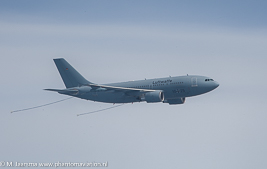 |
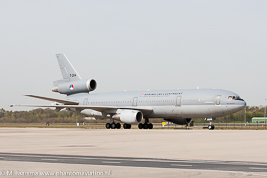 |
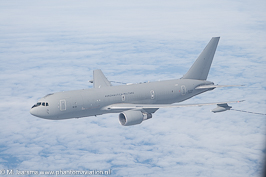 |
| A310MRTT German Air Force. | KDC-10 Royal Netherlands Air Force. | KC-767A Italian Air Force. |
|
One of the proposed initiatives was a dedicated AAR training. Forces
were joined between EDA, EATC and the RNLAF, last organized its annual
fighter exercise Frisian Flag (FF) at Leeuwarden air base. The fighters
are in need of AAR to execute their assigned missions. Major F.
Fröhlich, Exercise Director, presented the following data relating to
the current EART and FF exercise - compared to the FF exercises of last
years. - Until 2012 boom and drogue/hose tankers were only able to support the morning or afternoon mission. Limited time between both missions and the request for fuel offload exceeded the maximum fuel capacity. - In 2013 the KDC-10 and the A310MRTT supported both the AM and PM mission. A tanker planner was detached at Leeuwarden to coordinate the Frisian Flag AAR request. The German tanker operated from its home base Köln-Bonn Wahn airport. 2014 Eindhoven air base hosting tankers to maximize the tanker support for Frisian Flag. Both the RNLAF and German Air Force detached a tanker planner at Leeuwarden. The three tankers completed 2-4 mission per day in the first week flown by German and Dutch crews and completing 4-6 missions in the second week when the Italian Air Force KC-767A joined the exercise. Decided was to use Eindhoven air base as operating base for the tankers. It already offers the infrastructure and a limited transit time to the refuelling areas. Last were provided by Air Traffic Control who gave permission for a special air corridor in the more then busy Amsterdam FIR - supplying the tankers with quick transit times. Three air forces participated with tankers all with a different configuration:
Till April 9th the following missions were conducted:
Note: the KDC-10 offloaded 333.500 Lbs in 2012 and 570.000 in 2013 (19 missions flown). Mission planning started one day prior to the actual mission to be flown. Two tanker planners were detached at Leeuwarden air base and coordinated request from their FF counterparts. These were relayed back to the tanker planning cell at Eindhoven. Each morning at 06.30 the report and mass-briefing started. Tankers were assigned to either “blue” or “red forces” - with their respective refuelling tracks. Two areas were established with the blue forces using track ‘Shell’, located west of the Wadden Island Texel and red forces operating West of the Danish coast using track ‘Esso’. All the refuelling missions took part within flight levels 150 – 300. During the Distinguished Visitors Day the aircraft were assigned to FL 190 for the KC-767A, FL 230 for the KDC-10 supporting Dutch, Norwegian and Portuguese F-16s and FL 270 for the A310MRTT providing fuel for the German EF-2000s and Hornets from Finland. The first dedicated AAR-training already noted a number of lesson learned. The big advantage to use one forward operation base (Eindhoven) for the tankers resulted in face-to-face (de)-briefings at one location, mutual understanding of operation procedures for the different tankers to finally end up in an excellent set-up for the FF 2014 participants, combined training of both aircrew and logistics. |
| EART future |
|
In 2015 it is planned to organize an EART
again. The same conclusion can be drawn as with sister exercise
European Air Transport Training. The first exercise started small with
limited participants, but for EATT 2014 edition, ten nations will
already participate. For next year it’s likely the French Air Force will
participate, operational reasons kept them from participating this year.
Work has to be completed on certification of both fighters and tankers
towards the tankers. This is not as simple as it looks like - and it
takes time to be achieved. One advantage however is that, for instance,
one of the F-16AM/BM nations (Belgium, Denmark, Netherlands, Norway and
Portugal) can take care of the certification process with delivering of
all documents and processes to its colleagues. Current planning is to
certify the F-16AM/BM with the KC-767A in September. At the same time
both the KC-767A and KDC-10 should complete their tanker-to-tanker
certification. When completed, the tanker-to-tanker refuelling will be
part of EART 2015. A flexible host nation and air base has also to be
found: RNLAF/Eindhoven air
base already offered their services again in conjunction with the
Frisian Flag exercise next year. EART together with FF exercise have been concluded successfully - and with pillar 4 in full swing, Europe is set to become the second biggest AAR operator after the US on a long term basis within NATO - and will be able to conduct EU, UN and NATO missions around the globe with its own highly trained and capable AAR crews. The author would like to thank the following organizations and people: European Air Transport Command, European Defence Agency, Royal Netherlands Air Force. Captain N. Thomas (EATC), Colonel Johan van Soest, Major Fred and Captain Eric (RNLAF), staff voorlichting and personnel vliegbasis Eindhoven as well as the crews of the German, Italian and Netherlands tankers during their AAR missions. |
| EART 2014 Photo gallery |
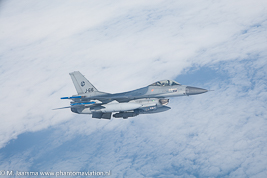 |
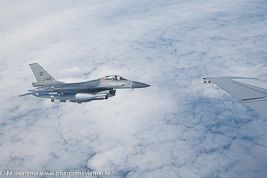 |
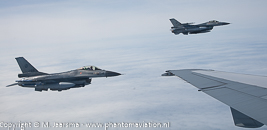 |
| Royal Netherlands Air Force F-16AM | approaching the KDC-10 and position | before taking on fuel. |
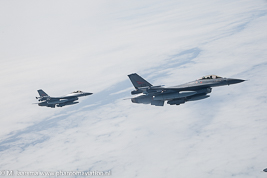 |
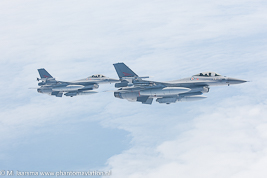 |
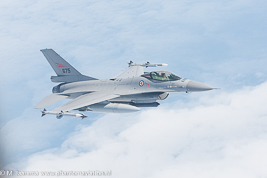 |
| The next receivers, Royal Norwegian Air | Force F-16s. | Maneuvering to the refuelling boom |
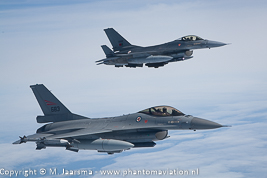 |
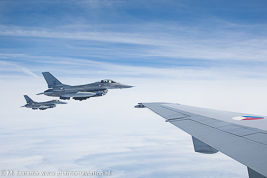 |
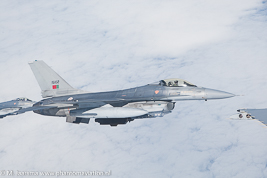 |
| Portuguese F-16s joining Norwegian | F-16s and wait for their turn to start the | refuelling process. |
|
|